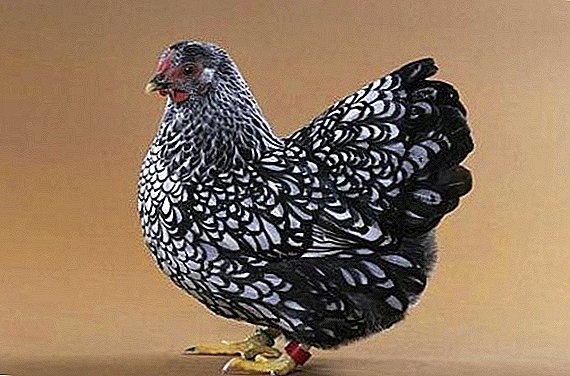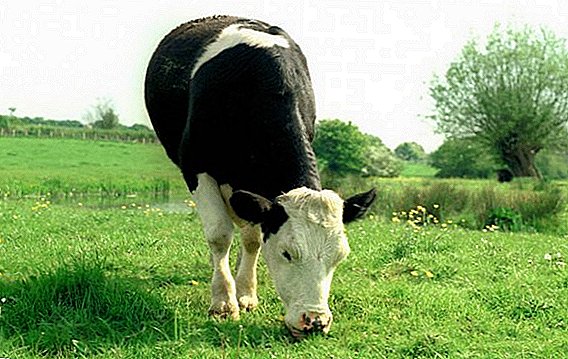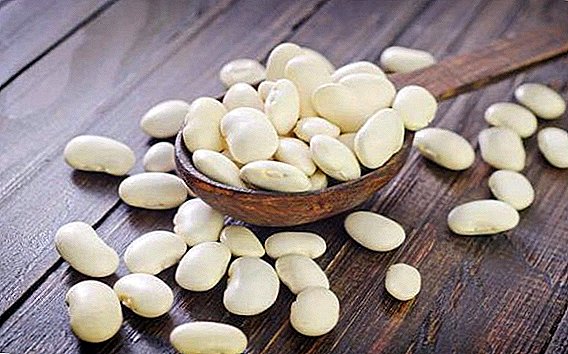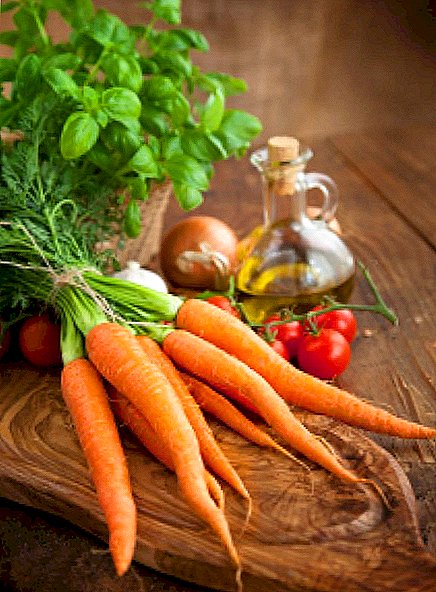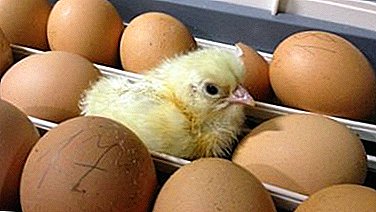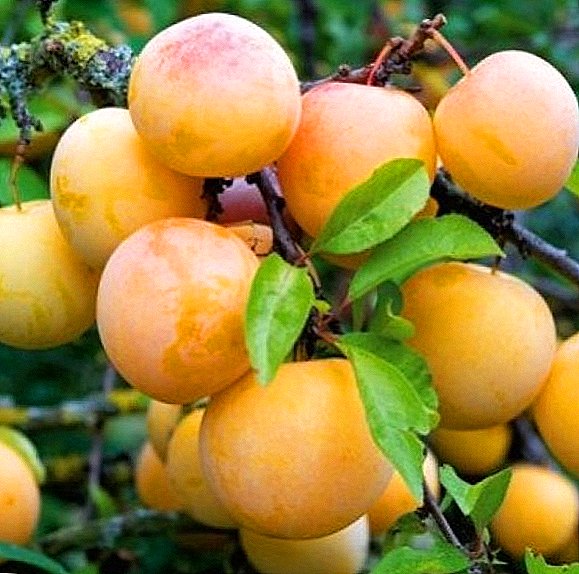 Plum - is one of the most common fruit trees in our country. The high yield of an unpretentious plant and the unsurpassed taste of fruits brought him great popularity. Thanks to the efforts of breeders, plum has gained many different hybrids that attract extraordinary taste and aroma. A separate niche is occupied by yellow plum, it is her varieties that will be considered in this material.
Plum - is one of the most common fruit trees in our country. The high yield of an unpretentious plant and the unsurpassed taste of fruits brought him great popularity. Thanks to the efforts of breeders, plum has gained many different hybrids that attract extraordinary taste and aroma. A separate niche is occupied by yellow plum, it is her varieties that will be considered in this material.
"Altai Jubilee"
This variety of plum is considered early and grows well even in places where other yellow plums cannot take root. It can be found in the western and eastern regions of Russia, as well as in the north of Kazakhstan.
All its best qualities plum "Altai Jubilee" took over from the Manchurian Prunes. It was from his seedlings that this variety was bred. Another one donor plant is considered to be the Immunnaya plum variety.
The fruits of the Altai Jubilee are angularly round and weigh on average 15 g. The main difference from other yellow plums is in a more orange shade of fruits that are covered with a bright red blush. The skin of these plums is thin and covered with white wax. This does not affect the main flavor of juicy flesh.
The taste of plums pronounced sweet and sour with a pleasant aroma. Stone in the fruit is easily separated and large. In the plum of the "Altai Jubilee" contains a lot of ascorbic acid - about 1 mg per fruit. Harvest can be in mid-August. 
The tree itself is practically no different from other carriers of plum varieties. In height reaches the average sizes. The crown is round, reverse pyramidal, medium thickened.
The most fruitful organs of this tree are the bouquet branches. From the skeletal branches depart straight shoots growing at an acute angle. The bark is mostly brown-gray. Plum "Altai Jubilee" shows good yield. This plum starts to give fruits only in the fourth year after planting.
Yellow plum of this variety tolerates frost and spring frosts. There are also disadvantages to the plant, but every gardener with enough experience will easily correct them.
First, the Altai Jubilee Plum is unsuitable for fresh transportation. You can, of course, transport it in canned form. Secondly, this variety is poorly resistant to diseases and pests that most often affect plums. This type of plum is not self-pollinating and is very afraid of droughts.
"Yellow Honey"
This variety of yellow plums has an unusual taste, reminiscent of natural floral honey. Although there are barely noticeable notes of sourness. The variety comes from Ukraine and has a wide zoning.
Due to its unpretentiousness, the plum Yellow Honey can grow even in the northern regions. The fruits of this variety are quite large - from 30 g. Some reach 50 g. The fruits have a regular rounded shape.
 The skin is thin, but very dense, yellow in color with a slight white wax coating. The flesh is juicy and has a bright yellow color. The structure of the fruit is dense, which complicates the process of separation of the bone from the pulp. This variety was given a tasting score of 4.5 points.
The skin is thin, but very dense, yellow in color with a slight white wax coating. The flesh is juicy and has a bright yellow color. The structure of the fruit is dense, which complicates the process of separation of the bone from the pulp. This variety was given a tasting score of 4.5 points.
Plum "Yellow Honey" - one of the earliest ripening varieties among all plums. Harvest ripe fruit is already possible in late July. This advantage is due to the early timing of flowering.
This yellow plum is self-infesting, therefore it needs cross pollination. The best pollinators are "Hungarian Early" and "Renklod Karbysheva". Tree "Honey" plum grows very large and can reach a height of up to five meters.
His crown is rounded with rare main branches. Due to this fruit can ripen quickly and efficiently. "Honey" - a high-yielding variety of plums. It shows good resistance to frost and tolerates even very low temperatures without problems.
Important! The grade "Yellow honey" does not demand any special leaving and perfectly gets accustomed in any climatic conditions.
 Fruits tolerate transportation and are versatile in home use. Many gardeners refuse to grow Yellow Honey on their plot due to the fact that it takes up a lot of space.
Fruits tolerate transportation and are versatile in home use. Many gardeners refuse to grow Yellow Honey on their plot due to the fact that it takes up a lot of space.
Someone argues that in its place you can grow two trees of another fertile variety and get a much larger crop. Others believe that you can donate square meters in order to enjoy such a delicacy. The choice is only for you.
Yellow Ball
This variety produces small yellow plums with amazing taste, somewhat similar to pineapple and peach. This variety can also be found under the name "Golden Ball".
Plum "Yellow Ball" differs from others in its special appearance. During the period of ripening, the spreading branches of the tree are covered with small yellow round fruits. From a distance, they can remind even the fruits of sea buckthorn. This is explained by the fact that the "Golden Ball" is a type of Chinese plum.
It is characterized by very early and abundant flowering. 3-4 buds grow on each bud. From other plums "Yellow Ball" is different tall.
 The tree reaches five meters in height. But the main thing is the frost resistance of this variety. The tree is able to withstand up to -50 ⁰C! In the period of fruiting enters the third year. It tolerates transportation and has a good overall quality.
The tree reaches five meters in height. But the main thing is the frost resistance of this variety. The tree is able to withstand up to -50 ⁰C! In the period of fruiting enters the third year. It tolerates transportation and has a good overall quality.
Plum "Yellow Ball" is resistant to common diseases of stone fruit crops. Along with many positive moments, this variety does not tolerate drought and is prone to sub-heating of the root collar. "Golden Ball" - a very productive variety of plums.
Important! Each fruit can weigh up to 60 g, so gardeners should be especially attentive to plum care. With its fertility, this may be fraught with strong deflection of the branches. Sometimes it is necessary even to put props.
"Yellow Hopta"
This is a vigorous plum variety with a height of 2.5 meters or more, but at the same time, the stem relative to the whole plant is not so large. The bark on the trunk of the tree is mostly gray and smooth to the touch.
In an adult plant, the crown is mostly sparse, but it also occurs in medium density. The top is round and slightly flattened. Krona are mostly spreading branches. The branches of the "Yellow Hoppies" are straight, but sometimes they are also slightly curved with a thick cross-section.
Light brown shoots with a glossy sheen. Vegetative buds on them are small, fruit - medium. The leaves of this medium-sized yellow plum are up to 11 cm long and up to 6 cm wide. They are most expanding closer to the top. The leaves are green with a slight glossy shine, have an egg-shaped form. On the surface can barely noticeable wrinkles.  Plum "Yellow Hoopta" blooms white cups with egg-shaped petals 9 × 7 cm. There is a slight waviness on the edges. Usually from one bud can appear up to three flowers.
Plum "Yellow Hoopta" blooms white cups with egg-shaped petals 9 × 7 cm. There is a slight waviness on the edges. Usually from one bud can appear up to three flowers.
Fruits are medium in size and grow within 20 g. They have a rounded, slightly flattened shape with a well-visible seam on the abdomen. The skin is thin, and the flesh under it is juicy and loose, yellow-green. The bone of the fruit is large, easily separated.
Plum "Yellow Hopta" - self-fertile fruit culture. Therefore, it is necessary to plant nearby trees of other varieties of plum, which bloom occurs in the same period as that of "Hopp".
Propagation of this variety occurs through grafting. At the moment, the best of suitable rootstocks are considered varieties of Canadian and Ussuri breeding.
Actively fruiting plum "Yellow Hopta" begins in the fourth year from the date of planting one-year sapling. Observing all the necessary agrotechnical conditions, gardeners will collect good yields of this plum.
 By average, up to 12 kg of fruit can be obtained from one tree, and from 6 hectares from one hectare. Fruits that ripen by the end of August have a wonderful taste with a predominance of sweet and teasing sour note.
By average, up to 12 kg of fruit can be obtained from one tree, and from 6 hectares from one hectare. Fruits that ripen by the end of August have a wonderful taste with a predominance of sweet and teasing sour note.
"A spoon of tar" in the general flavor bouquet - this is the peel, which gives a slight bitterness.
Important! In order for preservation not to be with an unpleasant bitterness, you should think about how to get rid of the specific taste of the skin - of course, only if you deliberately not plan to add spice.
We also note the commendable winter-hardy qualities of this plant, for the most part this concerns plum wood. Fruit buds are not designed for such extreme temperatures.
Therefore, this fact should be taken into account when breeding "Yellow Hopt" in your region. Gentle skin and loose fruit pulp does not contribute to transportation over long distances.
Did you know? Up to 3,000,000 tons of various products are produced from the plum fruit for the high season.
"Golden Large"
This is another great variety of yellow plum, characterized by the presence of very large fruits. It was bred as a result of the selection of seedlings of cultivated varieties zoned for the South-Russian region.
 The variety "Golden Large", which is also called the plum "Yellow Large-fruited", for the most part grows in the Lower Volga region. The average weight of the fruit is about 43 g. Yellow skin with splashes of pink blush.
The variety "Golden Large", which is also called the plum "Yellow Large-fruited", for the most part grows in the Lower Volga region. The average weight of the fruit is about 43 g. Yellow skin with splashes of pink blush.
Its structure is loose and tender, covered with a slight wax powder that can be easily removed from the fruit. Plum shape is oval. There are small one-dimensional grooves near the funnel and tops. The abdominal suture is practically invisible. The flesh is soft and tender, yellow, very juicy with a sweet-sour taste. Tasters rated the taste at 4.8 out of 5 possible points.
Yellow Large Plum occupies a leading position among all varieties in the content of ascorbic acid in fruits - 18.5 mg per 100 g of pulp. Blossom tree begins closer to the second half of May, 15-19 numbers. Therefore, the variety is late-ripening, and its fruits reach optimum taste only in early October.
The crown of the tree is pyramid and sprawling, but a small number of branches does not allow it to thicken. The main fructifying organ is the bouquet branches. The first fruits grow four years after planting, but the plum regularly and fruitfully. With an average of one tree, you can collect up to 27 kg, and from one hectare - up to 1.5 tons each year. 
This variety has many advantages:
- the regularity of fruiting and excellent taste of large fruits;
- wonderful appearance;
- high frost resistance of an adult plant. With flowering plum of this variety, even spring frosts are not terrible;
Important! Young wood suffers from frost and can recover for a long time after it. Sometimes freezing can completely destroy the young plum.
- tolerates long dry periods and is rarely attacked by pests and disease;
- harvested under the right conditions can be stored up to one and a half months. In addition, the fruits become even more attractive, and their taste more saturated.
"Compote"
This variety of plum was bred by A. Veliaminov from Russia. Yellow plum "Kompotnaya" does not quite fit the description of tree crops, as it has the shape of a shrub. Bush in height reaches three meters. Crown spreading with raised branches.
Important! Under the name "Kompotnaya" in nurseries there is also a tree form of plum. Tastes of its fruits are identical with the bush, however, their size is twice as large.
 Plum "Compote" - a variety that produces small fruits. They are round with a dense skin of bright yellow color and a weight of only 15 g, very similar to cherry plum. Pulp plums loose and juicy. Taste balanced sweet-sour. By name you can immediately guess about the direct purpose of this variety of plums.
Plum "Compote" - a variety that produces small fruits. They are round with a dense skin of bright yellow color and a weight of only 15 g, very similar to cherry plum. Pulp plums loose and juicy. Taste balanced sweet-sour. By name you can immediately guess about the direct purpose of this variety of plums.
Up to 20 kg of plums can be collected from one bush, which is an unexpected but pleasant indicator. Of the advantages can also be identified good resistance to frost.
Did you know? Plums contain more vitamin E than any other fruit and citrus fruit.
"Ochakovskaya yellow"
This is an old Russian variety with yellow-green fruits weighing up to 30 g. They are oblong and rounded with a small neck. The tree grows medium in size with elliptical foliage. "Ochakovskaya yellow" is a self-infested plum.
 Flowering begins later than other plums, and sometimes it does not produce a crop at all due to the lack of pollinating trees.
Flowering begins later than other plums, and sometimes it does not produce a crop at all due to the lack of pollinating trees.
Crohn in young trees with a narrow pyramidal shape. Root offspring bear fruit in the eighth year, and the vaccinated - already in the fourth.
If you provide trees with good care, then from one ten-year-old plant it will be possible to collect up to 80 kg of plums. Fruits mature by the end of August and easily showered. Their flesh is very juicy, tender and fragrant. Can be used both fresh and in processed form.
"Minsk"
This variety is widely distributed in the plots of land. Yellow plum "Minsk" is considered a vigorous variety with a thick rounded crown.
The tree blooms in late terms and is self-fruitless. Fruits are egg-shaped, weighing up to 50 g. The skin of the plums is dense, but thin, yellow-white in color with a slight flush.
 The flesh of the fruit is very juicy and sweet yellow. The stone is small, easily separated. Fruiting irregular and starts in the middle time. Each tree with proper care can bring up to 30 kg of crop.
The flesh of the fruit is very juicy and sweet yellow. The stone is small, easily separated. Fruiting irregular and starts in the middle time. Each tree with proper care can bring up to 30 kg of crop.
Like many other varieties of yellow plum, "Minsk" is suitable for central Ukraine and Russia. It has good winter hardiness.
Did you know? Plum stones contain amygdalin. When it enters the human body, it produces cyanide as a result of a chemical reaction. In large doses, it is particularly dangerous and even deadly.
"Memory of Timiryazev"
The plum of this variety grows up to 3 m in height. Crohn middle density, rounded and slightly drooping. Shoots light brown shade with a slight pubescence.
Buds are small and not pressed to escape. The leaves are quite large, light green in color. Their upper side is smooth, and the bottom is slightly bristly. Along the edges they are slightly jagged. Blooms "Memory Timiryazev" lush white flowers of medium size.
 The fruits are large, oval in shape, weighing up to 30 g. Their shape is oval, and the color is bright yellow with a reddish blush that appears on the sunny side. Under the skin appears a lot of small dots. The fruit has a slight wax coating. Side seam barely noticeable.
The fruits are large, oval in shape, weighing up to 30 g. Their shape is oval, and the color is bright yellow with a reddish blush that appears on the sunny side. Under the skin appears a lot of small dots. The fruit has a slight wax coating. Side seam barely noticeable.
The flesh is dense and fine-grained, does not differ in strong juiciness, with a sweet-sour taste and a faint aroma. It grows on a short stalk. The stone is small, easily separated from the pulp.
"Memory of Timiryazev" refers to late-ripening plums. Flowering begins in mid-May, and you can collect in late August. This variety is universal. Perfect for both processing and eating fresh. It tolerates transportation and is stored for a long time.
This plum begins to bear fruit in the fourth year after planting. Grows to 22 years. The yield from a single tree can reach an average of 35 kg.
Yellow plum "Memory of Timiryazev" is self-fertile, but to improve the quality of the harvest, the following varieties can be planted next to: "Moscow Hungarian" or "Skorospelka Krasnaya".
"Morning"
This variety is characterized by the average height of trees and the average density of the crown, which grows in the shape of an oval. The shoots are smooth, dark brown color with small buds.
The leaves of the plum are light green, oval and smooth on both sides. Veins of wrinkles run along the surface. Flower petals are not interlocking. In the flower there are 21 stamens and the stigma of the pistil towering above them. The flower has a bare ovary and a smooth pedicle of medium size.
 The fruits of the tree are oval, with a slight depression at the base, with a slightly perceptible abdominal suture and lacking pubescence. The fruits have a yellow-green shade with a light pink blush on the sunny side. Covered with wax white color. The juiciness and density of plums "Morning" is average.
The fruits of the tree are oval, with a slight depression at the base, with a slightly perceptible abdominal suture and lacking pubescence. The fruits have a yellow-green shade with a light pink blush on the sunny side. Covered with wax white color. The juiciness and density of plums "Morning" is average.
Pulp of yellow color with a fine-fibrous consistence. The average fruit weight is about 26 g. Sweet plums with a spicy aroma.
Yellow-fruit plum "Morning", like many other varieties, begins its fruiting in the fourth year after planting in open ground. Average life expectancy is 21 years.
Flowering occurs in the period from 12 to 20 May, and from 7 to 14 August the trees are already ripening fruits. Morning is one of the few self-fertile varieties of yellow plums. It is characterized by regular good yield. From one tree you can collect at least 15 kg of fruit. Plums tolerate transportation, are recycled and even frozen.
Severe frosts "Morning" endures with difficulty and subsequently does not bear fruit well. But the spring frost variety is not terrible.
"Tatar yellow"
This is a medium grade yellow plum variety. The crown of the tree is wide-oval and has an average thickness. The number of foliage is also average. Кора на штамбе и скелетных ветвях коричневого цвета с серым налётом, обычно шероховатая, иногда гладкая.
Побеги среднего размера, прямые и тонкие, порой слегка изогнутые. The leaves are small, rarely of medium size, broadly oval, light green, wrinkled and rough. The flowers are medium, sometimes there are large, white.
The fruits of the plum "Tatar yellow" are small, up to 15 g, broadly oval, asymmetrical, yellow in color and with an average degree of wax coating. The top is weakly depressed, there is a small funnel at the base, the abdominal suture is slightly visible. The skin is not thick and is removed without much effort. The flesh is yellow, medium juicy and dense, sweet and sour with a pronounced taste. Stone is well separated from the pulp. 
Plum "Tatarskaya" begins to bloom in mid-late May. Fruiting begins in the fourth year after planting. Fruits can be consumed at the end of August. They are suitable for consumption in any form.
The grade brings an average crop. It shows poor resistance to diseases and pests, but it tolerates heat and drought well. It is self-infertile and successfully pollinated by Tenkovskaya Blue, Rakitova, Tenkowsky, Blue Eyes plum plums.
Did you know? In the Middle Ages, resin from the trunk of a plum tree was part of ink for manuscripts.
"Early Loshitskaya"
The peculiarity of this variety in its excellent winter hardiness. The plum is self-productive and late-harvested. The crown of a tree has a triangular shape. Fruits are medium in size up to 35 g, juicy, soft, with a well-separated bone.
 The surface of the plum fruit "Early Loshitskaya" greenish-yellow color. There is a small blush. The taste is sweet with a slight sourness and a pleasant honey flavor.
The surface of the plum fruit "Early Loshitskaya" greenish-yellow color. There is a small blush. The taste is sweet with a slight sourness and a pleasant honey flavor.
This is an early variety of yellow plums. In the best years, up to 30 kg of plums were collected from one tree. Fruiting plant begins, like most other varieties, already in the fourth year.
"Egg Yellow"
One of the rarest vintage varieties, the first surviving mention of which dates back to 1676. Like most of the old varieties, the Egg Yellow plum is endowed with many flaws, but is of particular value to collectors.
Plum fruits are large, but not particularly tasty and sour. The skin color is bright yellow, the bone is not separated. Well suited for seaming stewed fruit and making pastila. It is not stored fresh for a long time and after a week it starts to deteriorate. 
The tree is vigorous, its crown is round and sparse. It has good resistance to frost and drought, but is poorly resistant to fungal infections. Fruiting begins late, somewhere in the seventh year of life. With good care from one tree can collect up to 40 kg of plums.



